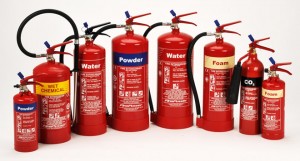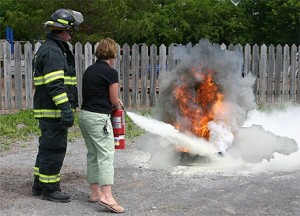Types of Fire Extinguishers
Importance Of A Fire Extinguisher In The Home
A fire extinguisher, flame extinguisher, or simply an extinguisher, is an active fire protection device used to extinguish or control small fires, often in emergency situations. It is not intended for use on an out-of-control fire, such as one which has reached the ceiling, endangers the user (i.e., no escape route, smoke, explosion hazard, etc.), or otherwise requires the expertise of a fire department. Typically, a fire extinguisher consists of a hand-held cylindrical pressure vessel containing an agent which can be discharged to extinguish a fire.
Identify What Is On Fire
This may sound like a silly question but get this wrong and it could be disastrous. You must be recognise the type of fire before grabbing the nearest extinguisher.
Believe it or not materials are placed into a class system if they burst into flames or are part of a fire. These classes include:
- Class A materials – These include solid materials such as wood, types of plastics and paper.
- Class B – These are all flammable liquids, so these include petrol, oil, and many other combustible liquids.
- Class C – This type of fire is quite rare and involves combustible gases that are used in such places as universities. These gases include methane, butane, and propane.
- Class D – Electrical fires full into this category so items include kitchen appliances, faulty wiring and electrical distribution boards.
- Class E type. Cooking oil and fat as well as other kitchen cooking material, which are of the greasy kind, would be found under the Class F kind.
Types of fire extinguisher
Water – This fire extinguisher is colour-coded red and can be used for Class A fires, ie solids only, such as wood, paper and fabrics. Not suitable for Class B liquid fires, eg paraffin, petrol, oil fires or where electricity is involved. It works by cooling burning material.
CO2 fire extinguishers are suitable for use on Class B fires and fires with an electrical complication. Its most typical application is for use on office machinery and IT equipment. In most cases they are not appropriate as the principle extinguisher type in a building as they are unable to achieve an A class rating.
Powder fire extinguisher are suitable for use on Classes A B C and electrical fires. It is a highly effective extinguishant but does present other problems. It drastically reduces visibility, it can cause choking and respiratory distress in confined spaces. It causes a great deal of mess and on exposure to atmospheric moisture can become corrosive.
Foam – This fire extinguisher is colour-coded cream and is more versatile than water. It can be used for both Class A and B fires, but is not recommended for fires involving electricity. This extinguisher forms a blanket or film on the surface of a burning liquid.
Wet chemical – This specialist fire extinguisher is colour-coded yellow and is used for Class F cooking oil or fat fires only.

